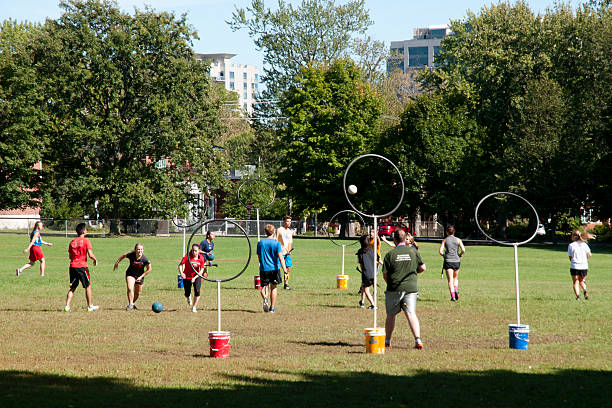General Rules of Rec Footy
Get ready to explore the essential regulations governing the game of Rec Footy. From the dimensions of the field to the rules of fair play conduct, understanding these guidelines is important for an engaging and competitive match. But did you know there's a specific scoring system in place that might surprise you? Stay tuned to discover how this unique aspect adds an intriguing layer to the game, making every goal even more significant.
Field Dimensions
When playing Rec Footy, make sure to familiarize yourself with the field dimensions to guarantee a fair and enjoyable game for all participants. Understanding the layout of the field is important for players to strategize effectively and navigate the game successfully.
Regarding equipment requirements, Rec Footy typically only requires basic gear such as appropriate footwear, comfortable clothing, and a mouthguard for safety. However, checking with the league or organizers if any specific equipment regulations are in place is vital. Ensuring safety measures are in place not only protects yourself but also your fellow players, promoting a secure environment for everyone involved.
Skill development in Rec Footy is an ongoing process that can be enhanced through various training techniques. Practicing ball-handling skills, improving agility and speed, and working on endurance are all fundamental aspects of becoming a proficient Rec Footy player. Engaging in drills that focus on these skills can improve your performance on the field.
Scoring System
Understanding the scoring system in Rec Footy is key to effectively track and determine the outcome of each game. In Rec Footy, there are two ways to score points: goals and behinds. A goal, worth six points, is scored when the ball is kicked through the two large goalposts. On the other hand, a behind, worth one point, is scored when the ball passes between a large and small goalpost, or hits a goalpost.
Goal kicking technique is vital in Rec Footy. Players often use a drop punt or a torpedo punt to kick accurately for a goal. Celebrations are common after scoring, with high-fives, fist bumps, and even choreographed routines adding to the fun.
Goal umpire signals play a significant role in the scoring system. When a goal is scored, the goal umpire waves two flags above their head. For a behind, the goal umpire extends one arm out horizontally. These signals help players and spectators keep track of the score.
Assists are not officially tracked in Rec Footy, but they are essential in setting up scoring opportunities. A well-timed handpass or a strategic kick can make all the difference in helping a teammate score. Understanding the scoring system and actively participating in goal assists can lead to a more engaging and successful game for everyone involved.
Player Positions
When it comes to player positions in rec footy, understanding offensive and defensive roles is key. Players often rotate positions throughout the game to adapt to the flow of play. By familiarizing yourself with different positions and their responsibilities, you can contribute effectively to your team's strategy.
Offensive and Defensive
In Rec Footy, player positions for offense and defense play important roles in shaping the flow of the game. When considering offensive strategies and defensive formations, it's essential to understand the following:
- Offensive Strategies:
- Utilize quick passing and movement to create scoring opportunities.
- Maintain good spacing to stretch the opposition defense.
- Look for chances to exploit mismatches or weaknesses in the defense.
Effective offensive strategies can help your team break down the opponent's defense and increase your scoring chances. On the defensive end, formations play a key role in stopping the opposition's attacks and maintaining a solid defensive structure. By understanding these principles, you can contribute significantly to your team's success on both ends of the field.
Rotating Positions
To maximize effectiveness and adaptability on the field, players in Rec Footy often rotate positions throughout the game. This position strategy helps maintain a balanced team dynamic, allowing players to exploit their strengths in different areas of the field. Important team communication is significant when implementing position rotations, ensuring that everyone is aware of their roles and responsibilities at any given time. By rotating positions strategically, teams can keep their opponents guessing and create favorable matchups. Players should be flexible and open to changing positions to support the team's overall strategy. Remember, effective position rotation not only enhances individual player skills but also contributes to the team's success on the field. So, stay alert, communicate well, and be ready to adapt to different positions as needed.
Game Duration
The typical duration of a Rec Footy game is around 40 minutes, divided into two halves with a short halftime break. This game duration is carefully structured to balance gameplay excitement with player fatigue, ensuring an enjoyable experience for all participants.
- Time management: The allocated time for a Rec Footy game is optimized to allow players to showcase their skills, engage in strategic gameplay, and immerse themselves fully in the match without feeling rushed or overly extended.
- Player breaks: The halftime break provides players with a brief moment to catch their breath, rehydrate, and discuss tactics with their teammates. These short intervals are critical for maintaining player performance and preventing exhaustion throughout the game.
- Strategies, game pace: With a clear understanding of the game duration, teams can develop effective strategies to pace themselves, adapt to the flow of the match, and capitalize on scoring opportunities. The duration of the game influences the overall pace, encouraging teams to find a balance between aggressive attacks and defensive stability.
Ball Handling Rules
After understanding the game duration and how it impacts player performance, mastering the ball handling rules in Rec Footy becomes essential for maintaining possession and executing successful plays. When it comes to ball handling, two key aspects to focus on are passing techniques and catching skills. Effective passing techniques involve using both hands to pass the ball accurately to your teammates. Additionally, mastering catching skills is critical to make sure you can secure the ball when it is passed to you.
| Passing Techniques | Catching Skills | Ball Control | Dribbling Strategies |
|---|---|---|---|
| – Use both hands | – Focus on the | – Keep the ball | – Use your fingertips |
| to pass accurately | incoming ball | close to your | to maintain better |
| – Aim for your | – Position your | body to prevent | control over the |
| teammate's chest | hands properly | turnovers | ball |
Additionally, ball control and dribbling strategies are vital components of mastering ball handling in Rec Footy. Keeping the ball close to your body while moving across the field can help prevent turnovers and maintain possession. Dribbling strategies involve using your fingertips to have better control over the ball, enabling you to maneuver past opponents more effectively. By honing these skills, you can significantly enhance your gameplay and contribute more effectively to your team's success.
Substitution Guidelines
When it comes to substitution guidelines in rec footy, understanding the timing for substitutions, player eligibility criteria, and the procedures for substituting is important for a smooth gameplay experience. Make sure you are aware of these points to guarantee fair play and adherence to the rules. Following these guidelines will help maintain the integrity of the game and keep things running smoothly.
Timing for Substitutions
To guarantee smooth changes on the field, timing for replacements in rec footy follows a strict guideline to maintain the flow of the game. Quick switches and strategic subs are essential to keep the momentum going and adapt to the evolving dynamics of the match. Bench management plays a vital role in deciding when to make substitutions. Understanding game strategy is key to knowing when a player needs to be replaced to enhance the team's performance. Always consider the current state of play and the specific strengths of your players when deciding on the timing of substitutions. Making timely changes can be a game-changer and give your team the edge needed for success.
Player Eligibility Criteria
Curious about who can be substituted in rec footy matches? When it comes to player eligibility criteria, there are a few key requirements to keep in mind. First and foremost, all players must be part of the team selection before the match starts to be eligible for substitution during the game. It is important to follow these guidelines to make certain a fair and enjoyable playing experience for everyone involved. Team selection plays a vital role in determining which players can participate and be substituted, maintaining the integrity of the game. By adhering to these eligibility requirements, you contribute to the smooth running of rec footy matches and uphold the spirit of camaraderie and sportsmanship within the team.
Procedures for Substituting
Substitutions in rec footy matches follow specific guidelines to guarantee fair play and participation for all players involved. When implementing substitution strategies, it is critical to make smooth changes and effective team communication. Here are some key points to take into account:
- Timing is Key: Substitutions should be planned strategically during breaks in play to minimize disruptions and maintain the flow of the game.
- Clear Signals: Players coming off the field and those entering should use clear hand signals or verbal cues to avoid confusion.
- Stay Ready: Being prepared to substitute at any moment keeps the team dynamic and ready to adapt to changing game situations.
Effective substitution strategies and open team communication contribute to a cohesive and inclusive rec footy experience.
Fair Play Conduct
In maintaining vital play conduct during Rec Footy games, all participants are expected to adhere to the established rules and regulations to guarantee a positive and enjoyable experience for everyone involved. Sportsmanship is a fundamental aspect of Rec Footy, encompassing respect for opponents, officials, and teammates. It involves displaying integrity, fairness, and graciousness in both victory and defeat. Upholding good sportsmanship fosters a welcoming and inclusive environment where camaraderie thrives.
Etiquette is another essential component of fair play conduct in Rec Footy. This includes following the guidelines for player behavior, such as refraining from aggressive actions, trash-talking, or unsportsmanlike conduct. Practicing proper etiquette contributes to a harmonious atmosphere on the field and promotes mutual respect among players. Remember, Rec Footy is not only about competing but also about building relationships and having fun together.
When engaging in Rec Footy matches, it's essential to prioritize fair play conduct over winning at all costs. Compete with passion and determination, but always uphold the principles of sportsmanship and etiquette. By embodying these values, you contribute to a positive and enriching recreational sports experience for yourself and all participants involved. Let the spirit of fair play guide your actions on the field, and enjoy the game to the fullest.
Frequently Asked Questions
Are There Any Restrictions on the Types of Cleats or Shoes That Can Be Worn During Rec Footy Games?
When playing rec footy, feel free to wear any cleat styles you prefer. There are no strict rules about brand preferences. Shoe material and color choices are up to you, so pick what makes you comfortable and confident.
Can Players Wear Any Type of Protective Gear, Such as Helmets or Padding, During Rec Footy Matches?
When it comes to safety regulations in rec footy, you have the freedom to wear protective gear like helmets or padding. While it can impact gameplay, prioritizing head protection is essential for your well-being.
Is There a Specific Age Requirement to Participate in Rec Footy Games?
To play rec footy, you must meet the age requirements set by the league. Eligibility criteria guarantee a safe and fair game for all participants. Make sure to check the specific rules before joining.
Are There Any Specific Rules Regarding the Use of Equipment, Such as Mouthguards or Shin Guards, During Rec Footy Matches?
When playing rec footy, you must prioritize safety with mouthguard requirements and shin guard regulations. Protect your smile and shins while enjoying the game. Remember, safety gear enhances your performance and keeps you in the match longer.
Are There Any Specific Guidelines on the Use of Physical Contact or Tackling During Rec Footy Games?
When playing rec footy, remember safety first. Proper footwear is essential. Follow guidelines on physical contact and tackling. Be mindful of safety precautions. Confirm equipment regulations are met, like wearing mouthguards and shin guards.






